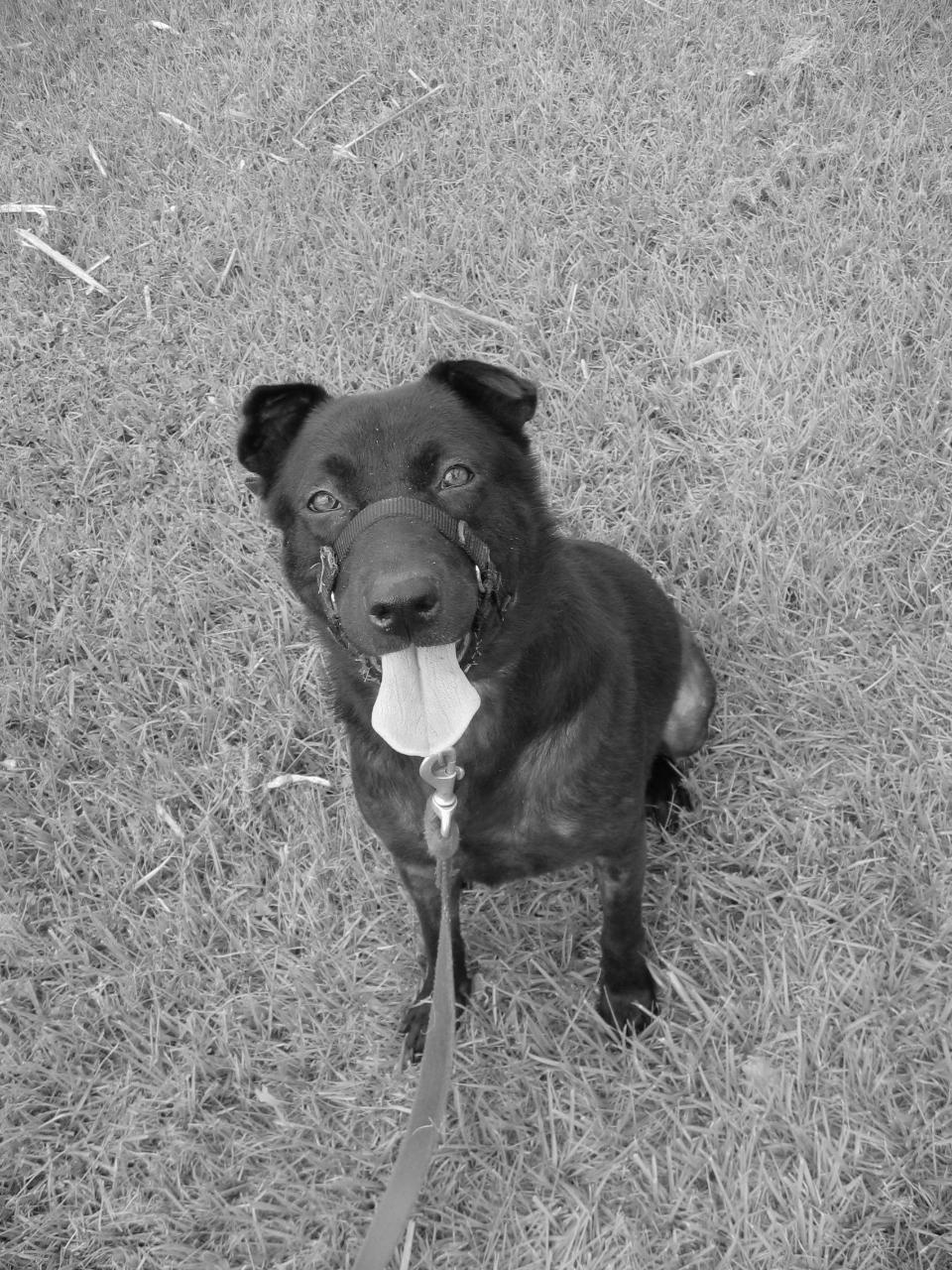Tips are meant to be just that - simple suggestions for new, interesting training ideas. They are no substitute for the guidance of a professional in your area. Always consult a veterinarian before beginning new workout routines with your pet(s) and use common sense to keep you and your pets safe.
2021-03-25 Flexibility in action: Target training critters
As a trainer, I always say, “Start by training each individual separately, and then bring them together to practice.” But, let’s be real, sometimes you just don’t have the space (or the heart) to separate everyone.
These young cats are just learning “target” training (touching their nose to the target ball on the end of the stick), which is a fundamental for many other tricks and behaviors. Cthulhu (6mon old) has never tried this (but does know nose-to-hand targeting). All the critters know their own names already.
So how do we get all four of them to cooperate? 1) We choose an extremely high value treat to capture their attention, 2) reward quickly and frequently, 3) accept imperfection, and 4) keep training sessions extremely short (this session was 2.5min, ‘one churu stick’).
It wasn’t my plan today to include Cthulhu, but she showed so much interest that I didn’t want to deny her enthusiasm. In the full length video, you can see Cthulhu tries to target my hand (even though we use a different cue for that), rather than the ball, but with a few verbal redirections & some animation of the target, she nails it!
Usually, I don’t advocate for negative verbal feedback when teaching a new skill, but Cthulhu gets frustrated easily if she doesn’t know the game, so giving her clearer feedback about the desired vs undesired behavior is paramount to keeping her engaged. If I criticized the Golden Retriever when he tried to learn something new, he wouldn’t enjoy training; he’s very, very motivated to please humans, and so he will keep trying new things and failing at them happily for your attention, but negative feedback when he’s confused would just upset him.
Cthulhu wants to win the game NOW, so providing her a clearer framework so she can succeed is a must. Every critter has their own ‘secrets’ that make them want to work for you, so keep your eyes and ears open to figure out your critter(s).
You can see everyone is eager to continue training, and while some (Caramel) show more precision for this new skill early on, they are all learning and enjoying. Be patient, be fair, and have fun!
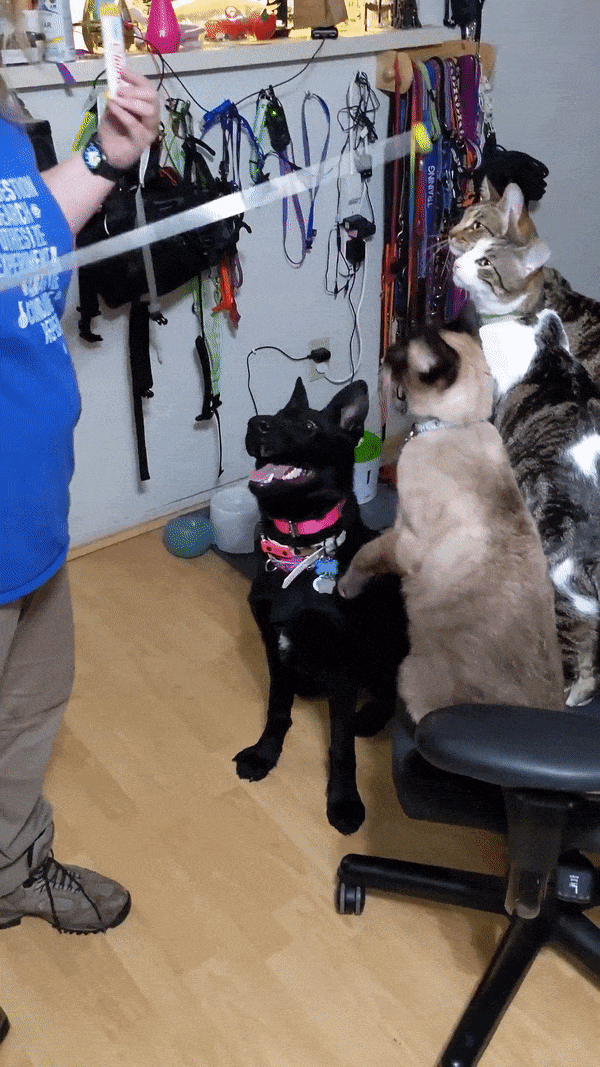
2021-03-07 They’re all good dogs.
We love the #NoBadDogs movement and the #MuzzleUpProject for helping to spread awareness about reactive dogs, insecure dogs, and all dogs whose public presentation may not be as crisp as folks expect.
On this hike, we have dogs from many different backgrounds and breeds, but they’re all getting along and listening to their handlers (well, mostly - @adventures_of_flerken had a few brain fart moments today 😂).
Even a few months ago, this walk would not have been possible with these same dogs! Their owners have put in a lot of time, patience, and love to help these dogs understand how the world works. This training has paid off for all parties, since understanding boundaries and expectations allows dogs and humans to take on new, fun adventures.
After this >2hr hike, we had a nail trimming party, with treats galore, and everyone did so well! All the stolen moments of desensitization training for the past few months paid off, and all the dogs made it look incredibly easy.
Want to do more with your dog? Start with simple obedience and fun games, on leash or around the house, and build up a little everyday. Remember to be fair, kind, consistent, and calm.
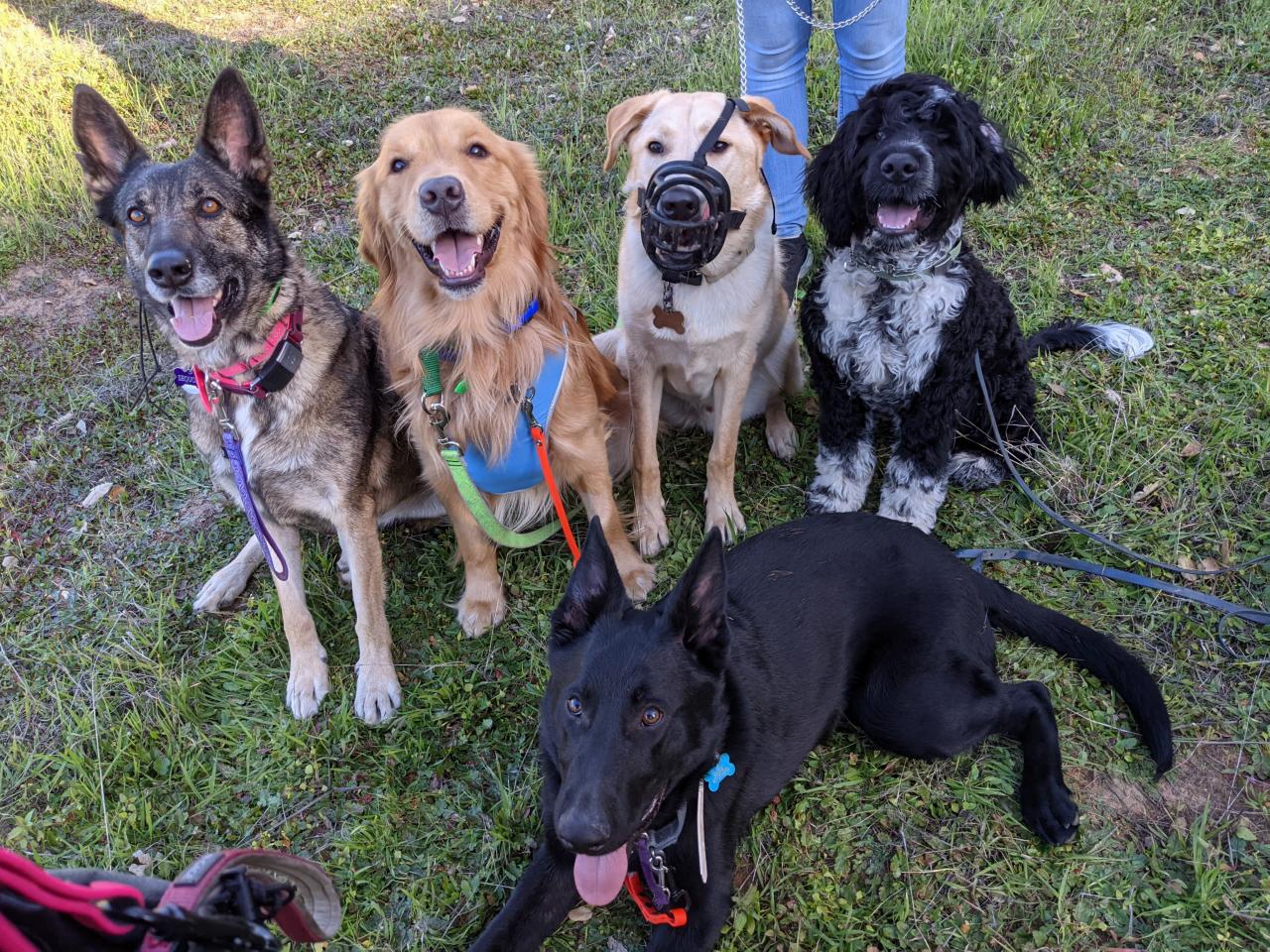
2021-02-25 Creating Calm
Helping a busy mind settle is one of the best things you can do for your puppy. It can also be really tough! Start with small, achievable goals and move up to longer settles with more distractions.
Cthulhu here shows off a “puppy cradle” at 5mon old. She’s calm & relaxed hanging out with her handler, even though there are other dogs present. Spoiler alert: she ran around, played, and had structured exercise time for over an hour before this moment. Exercise first, always!
Cthulhu was terrible at any form of restraint when she was ~8wks old - she squirmed and screamed about it, even though she had no prior experiences (and so no negative experiences). We worked with her every day to help her learn that being restrained (like she will be for veterinary care for the rest of her life) is a great thing that gets you lots of toys/affection/treats. By the time she visited the vet at 10wks, she was “exceptional for her age” during the exam. We’re not asking puppies not to be ‘puppies’ - just helping them to navigate the situations we know they’ll face by building them up slowly and positively.
Before you begin any focused or calming work, be sure your puppy has had sufficient physical, mental, and social exercise. Always strive to find your own Zen first, so you can be patient, fair, and kind.

2021-01-30 Train the dog in front of you.
Particularly on social media, it’s easy to fall into a ‘compare despair’. Try to only ever compare you and your dog to you and your dog yesterday. Small, incremental successes lead to huge changes over time.
Now, that’s not to say, “don’t try new things” - but go at your own pace and focus on the success of building up your partnership with your dog. If you or your dog are frustrated, maybe this isn’t the trick to start learning today.
We started our training session today with a short, structured pack walk. Then we had a couple of hours of mixed time - play sessions, trick training with multiple handlers, chances to practice meeting new dogs with proper manners, and pockets of truly ‘free time’ sprinkled throughout. Then we did a structured walk home.
The dogs still hadn’t had breakfast, so they were very motivated to earn a highly coveted frozen food puzzle. Here’s where we do the toughest training!
Sequoia, our rescue Shepherd, hasn’t been great in a crate. She doesn’t fight or whine to get out, but she doesn’t love going in AND sometimes she won’t eat a reward in the crate (a telltale sign of dogs shutting down). Since she came from an unknown background through the shelter system, we know that crates have represented a lot of stress for her.
So today, after exercise, structure, and play time, I asked her to go in the crate with the delicious food puzzle in my hand, and what did she do? Marched right in! Then I closed the door as I gave it to her, and she plopped right down to have her hard-earned snack. When she finished, she fell asleep, and THAT is when I opened the door. When she was completely relaxed.
These little victories are made possible by the work we’ve put into our relationship and by truly tiring her out before asking for something big; the amount of mental, physical, and social energy she expended today was huge, and she was happy to rest and refuel.
Does your dog struggle with a specific behavior or request? Work on it when they are most fulfilled as a dog, and you’ll see them shine.
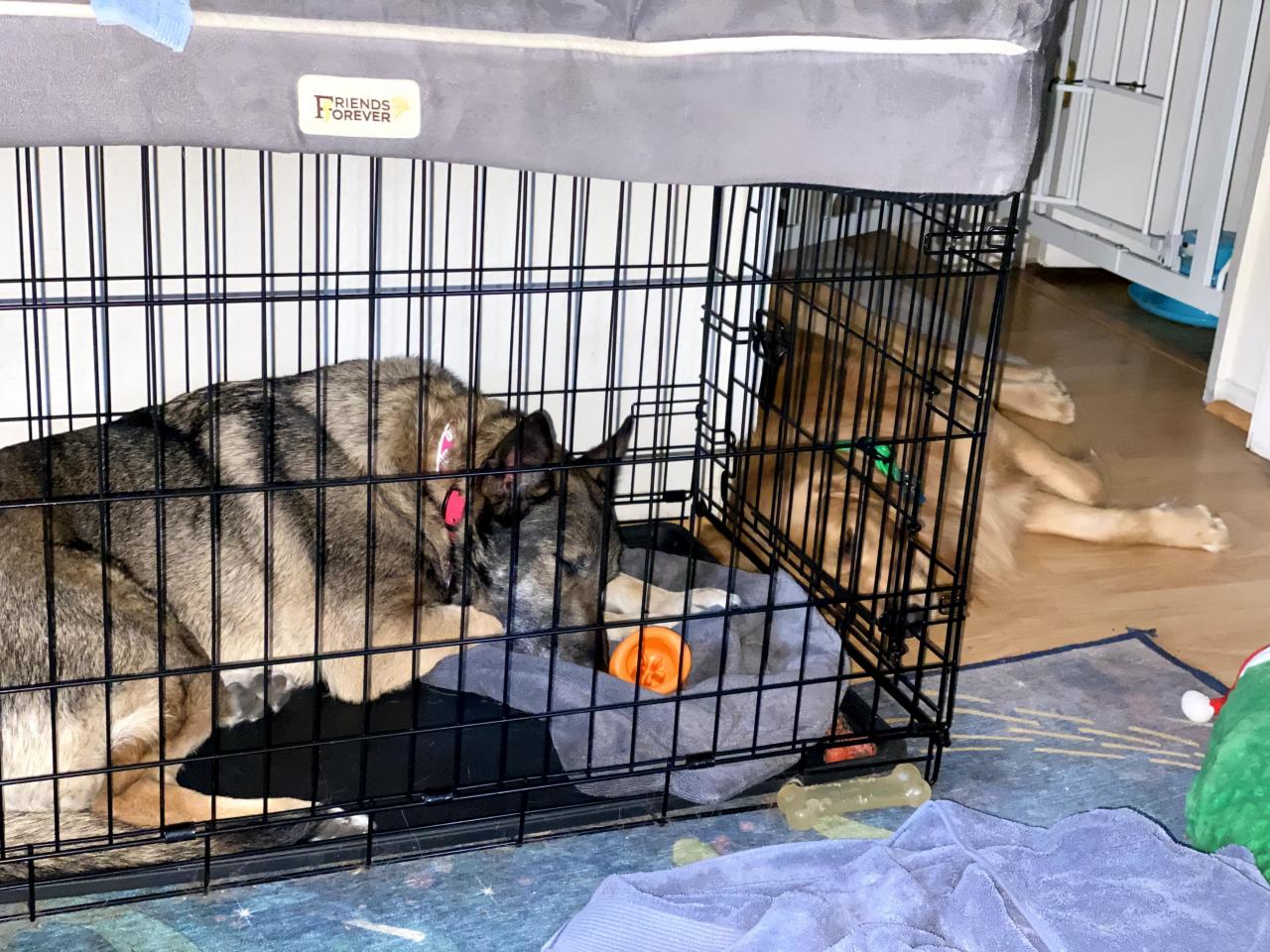
2021-01-12 “Touch” (two-paw targets)
Cthulhu (16wk) shows off her paw-targeting skills while on an outing at the Ruth Bancroft Botanical Garden.
It’s important to practice skills and commands in a variety of settings to ensure your puppy or dog thoroughly understands. Remember to be patient and flexible when asking for a behavior in a new location with new distractions. Ask your veterinarian or trainer for recommendations if you’re looking for safe, dog-friendly places to practice. We’re very fortunate to have many parks, recreational spaces, and gardens that allow dogs.
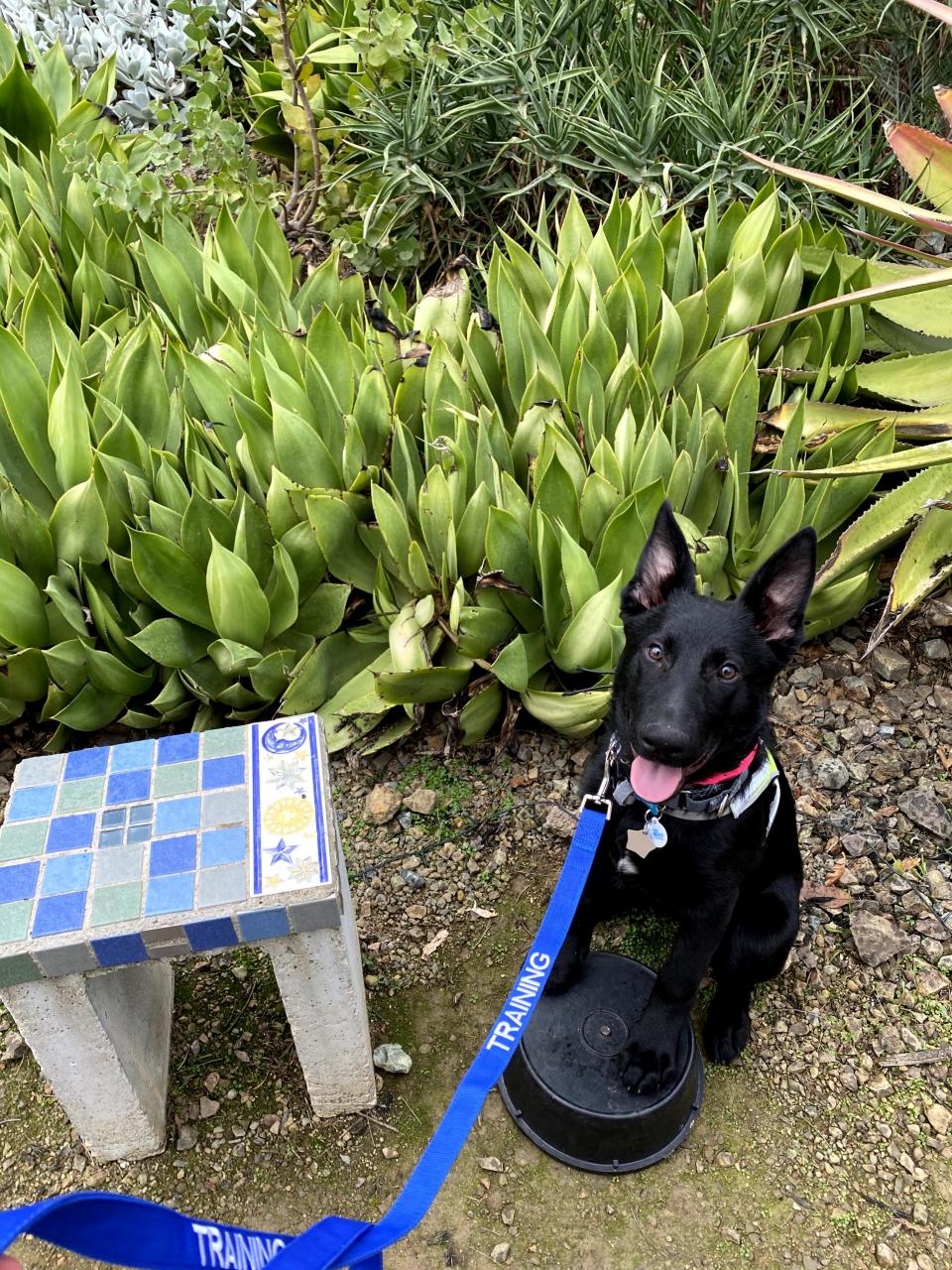
2021-01-02 Let’s talk about recall
This is @adventures_of_flerken, posing near the Golden Gate Bridge on a dog beach in San Francisco.
How do you build up a recall so strong that your dog will leave behind the waves, picnickers, and other dogs (and their toys) to come see you? Practice!
A good recall needs a strong foundation- start by calling your dog to you in your home when they are not distracted (e.g. not during dinner), while they’re on a leash (in case they need help figuring out what you want, you can put a little pressure on the leash to guide them to you), and while you have a very high value treat or toy. When your dog takes that first step towards you, start verbally praising! A single step towards you is the right choice, and that’s when we want to start rewarding. Once they arrive, give them the toy/treat/affection immediately.
Did your puppy get too excited and crash into you? Jump up? Or do something else less-than-desirable? My strategy is to ignore that, and still reward the heck out of them. We can work on how they come to you, and what is an appropriate way to greet you (sitting; not jumping up) once they know without a doubt that coming to you when called is AWESOME! Practice this 10 times a day (or more if you’re WFH!) spaced out at least ~2-3 min (ideally 5 in the morning & 5 at night).
Next step? On a walk, on leash, call your dog to you when they’re a little ahead or behind (NOT when they’re very distracted by a squirrel or another dog). Be sure to have that high value reward with you when you practice. You want your dog to think they are the BEST, SMARTEST, MOST ADORED dog ever when they come to you.
Keep that up for a month, and you’re ready to try some distractions and/or some longer leashed distances (on a long line ~15-20ft).
Set your dog up to succeed! If you aren’t sure your dog will come, and you don’t have a leash on them, don’t call. Use another sound or gesture (Hey! Whistle, clap, squeak, kiss, etc.) to encourage them to come without risking the consistency of your main recall (whatever you’ve chosen, often “come” or “name”).
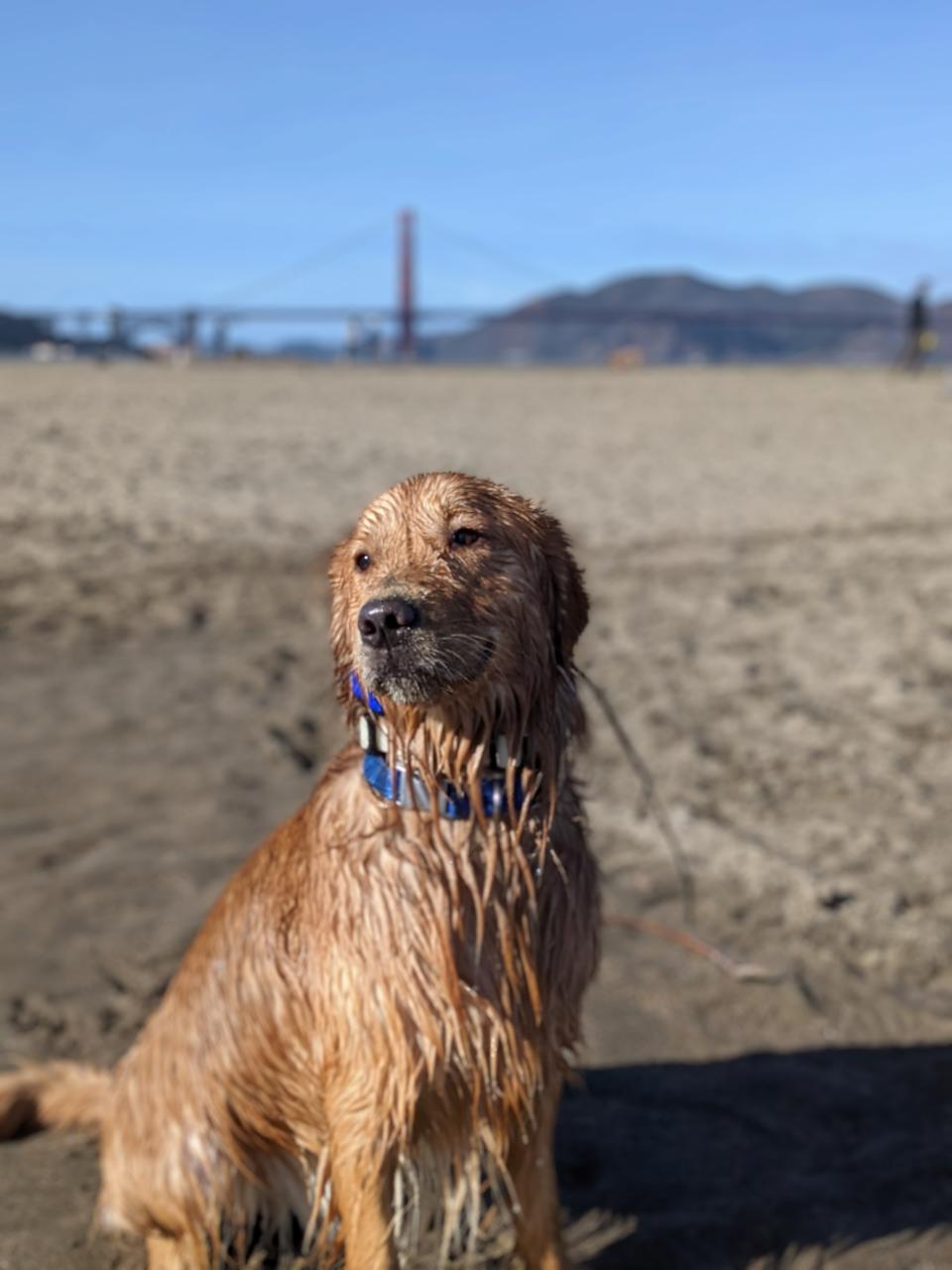
2020-12-20 Practicing Calm
Rewarding calmness in puppies can be really tough, but it’s a vital life skill. Here, we show Cthulhu (aka #raylapuppyface ) practicing a nice, calm exit from her travel crate in the car.
Start with small victories and build! A second of calm will lead to a minute with patience and positive reinforcement.
Center yourself before you begin to ensure you bring calm energy to the interaction.
Each puppy or dog will learn and react differently, so be flexible in your approach if things aren’t working.
We practice waiting calmly with high value toys, treats, and activities. It’s great to share excitement with your pet, so long as you’re also spending time developing & sharing serenity.
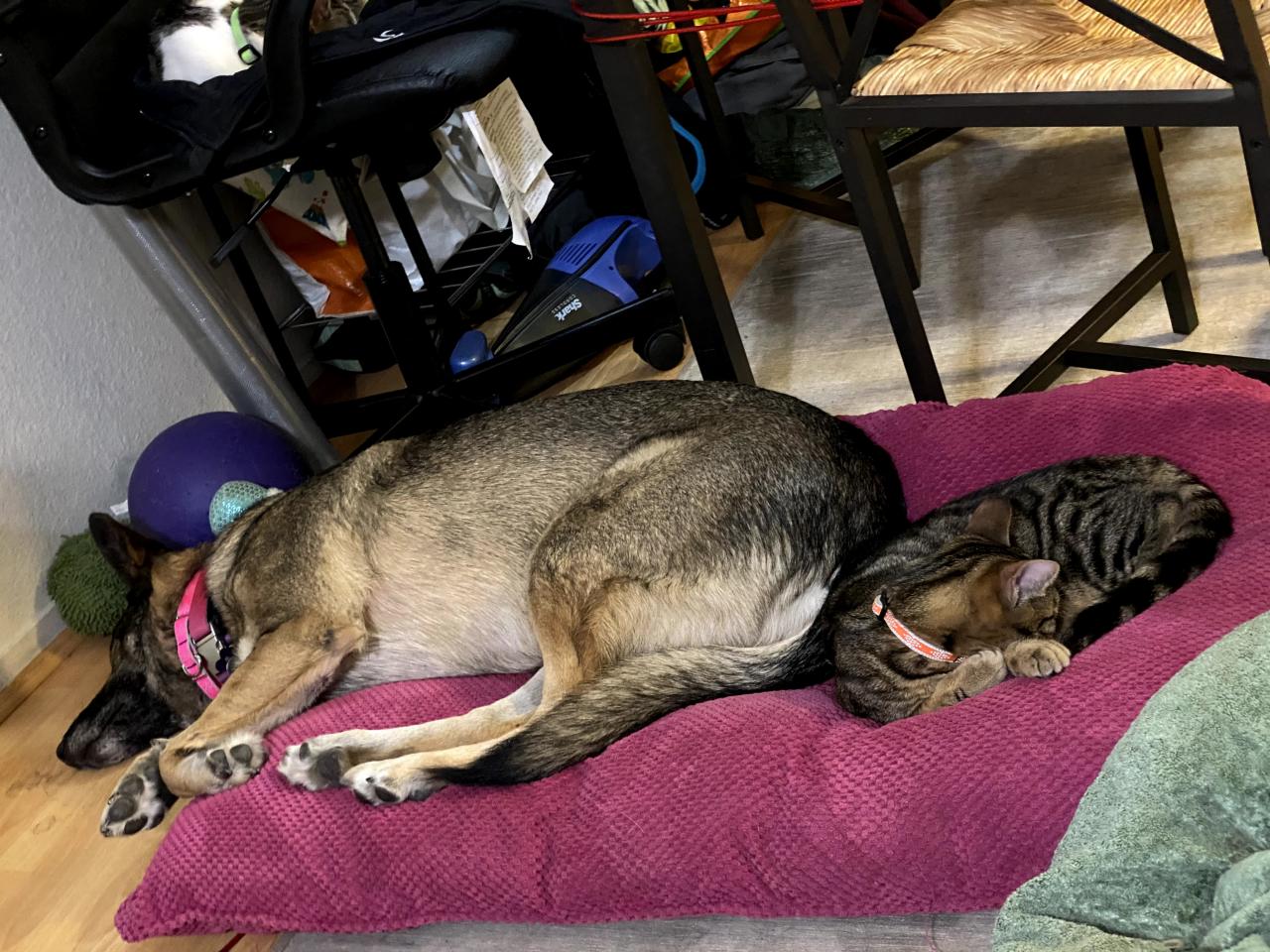 Two sleeping pals show off the power of calm; a formerly-feral kitten and a rescue German Shepherd share a bed peacefully after practicing calm separately in the home during an adjustment period.
Two sleeping pals show off the power of calm; a formerly-feral kitten and a rescue German Shepherd share a bed peacefully after practicing calm separately in the home during an adjustment period.
2020-12-13 Bath time tips
Bath time doesn’t have to be stressful for either of you! Starting young is definitely easiest, but an adult dog can learn to be calm for baths, too.
Here’s our recipe for bath time success:
-
encourage a calm mindset in your dog at home, on walks, in the car, etc to help them practice a relaxed state of mind. This will help translate to a calmer dog during bath time, too.
-
Practice touching them all over when they’re relaxed at home first.
-
Exercise first! A tired dog finds their calm dog-selves more easily, so be sure to do a long walk, hike, bike, play session, or other physical activity right before hand.
-
Bring a toy or snack your dog LOVES! Having something for them to focus on other than the water/soap/tub will help keep them in a more comfortable state of mind.
-
Take your time! There’s a saying in horse training: “if you act like you have 15min, it’ll take you an hour; if you act like you have an hour, it’ll take you 15min” - your patience and calmness will help your dog find their zen, too.
-
Recruit a friend! Having an extra set of hands or two can help you immensely to grab towels, pick up dropped brushes, and even just feed treats while you wash. Particularly for the first bath, a team can make the experience faster, easier, and less stressful.
-
Don’t aim for perfection! If this is your dog’s first bath with you, it’s more important that they have a quick dip than a spa day - just like all training, we want to keep it short and end positive.
-
Don’t spray their face! No one likes water or soap sprayed in their face or eyes. Try instead to pour water over the base of your dogs neck and skull, then gently wipe some of the water over the top of their head and down onto their muzzle. It’s better to skip their face now and do a wet wash cloth later than to overwhelm them. Check out a short video here
-
Have a plan to celebrate (zoomies, toys, towel rub downs, a game of tug) and take a potty break afterwards, too. If your dog was nervous during the bath, this will help release all the built up tension.
Always aim to be safe, fair, and kind.
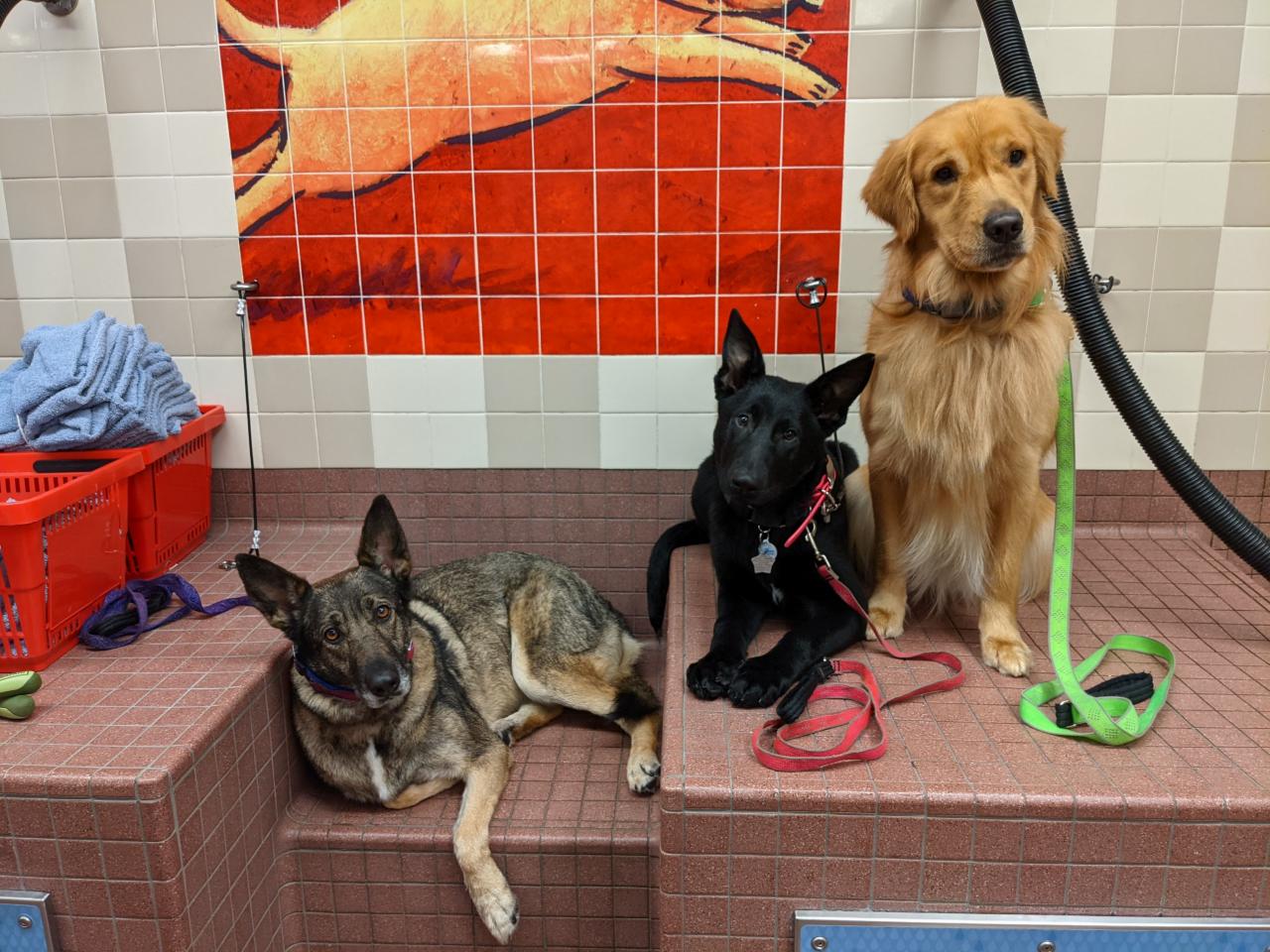
2020-12-08 Practicing ‘wait’ (aka stay)
Sequoia is a ~6yo German Shepherd (or GSD-mix) from the shelter. When she came to us in July (2020), she was fearful, shy, sick (heart worms), and had no basic obedience. Here, she is practicing ‘wait’ after months of restoring her health and building some ‘basics’ (clicker training, sit, touch, and shorter distance waits inside). She does great! She only breaks when I move closer to the sidewalk where there are other people, and she even gets that by the end of the video.
This two minutes is the entire exercise for ‘wait’ that we’ll do for today - these short practice sessions where she finishes on a positive note are important to building up her confidence and ensuring she enjoys training.
Check out the video here
Here’s a gif of three dogs waiting and listening for their turn to be released. This is a great example of how practicing ‘wait’ can make everyday life a bit less chaotic - no traffic jams!
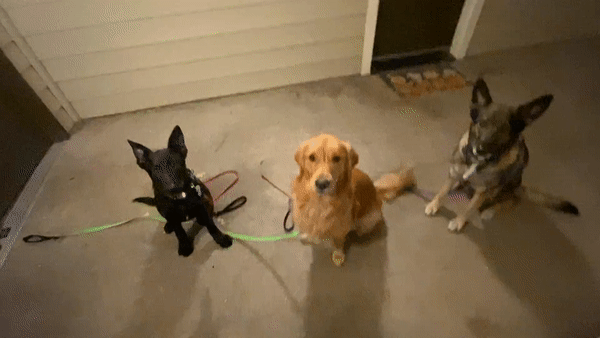
2020-12-02 Group Sit (two-paw targeting, sit, working around other dogs)
Sequoia is a ~6yo German Shepherd (or GSD-mix) from the shelter, Rayla is a 3mon old German Shepherd puppy, and Goose is a 1.3yo Golden Retriever. Independently, we’ve been teaching the “two-paw touch” to these pups, and today, for the first time, we try it with them all together. There were plenty of outtakes with a 3mon old puppy, but the two adult dogs stayed really consistent even with Rayla providing distractions. Notice that I feed the two ‘newer’ dogs first, since they have the least practice and need reinforcement more urgently to mark desired behaviors; Goose knows he’ll get rewarded because of the continuation marker alone, and he waits patiently to receive his treat. It’s important to train each dog separately, then work on training together, to ensure they learn the training goals with and without their pals around. Some dogs will struggle with this more or less, so be patient and set your dog(s) up for success.
We ran these ‘together’ exercises in ~1-2 mins, and then broke the group apart so the adult dogs could work on individual training for another few minutes. Short training sessions keep everyone happy and wanting to learn more.
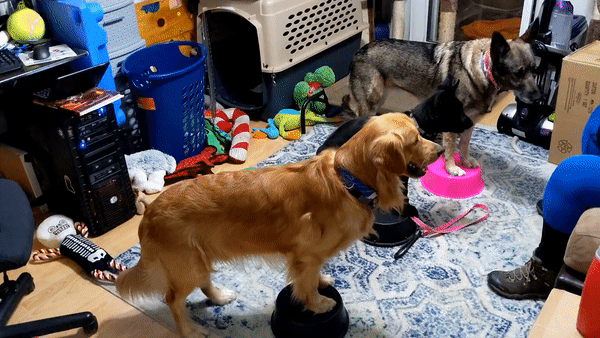
2011-12-11 Dog Tired
Our lives & schedules are often full and/or unpredictable, but both dogs and cats require physical and mental exercise. If you make time to meet your pet’s needs, your home will be far more peaceful.
Here two large dogs take a break from their exercise routine to catch their breath. Working breed dogs like these require more mental stimulation than just a standard walk or jog - try varying your routines and training on-the-go to help keep them engaged and prevent boredom.
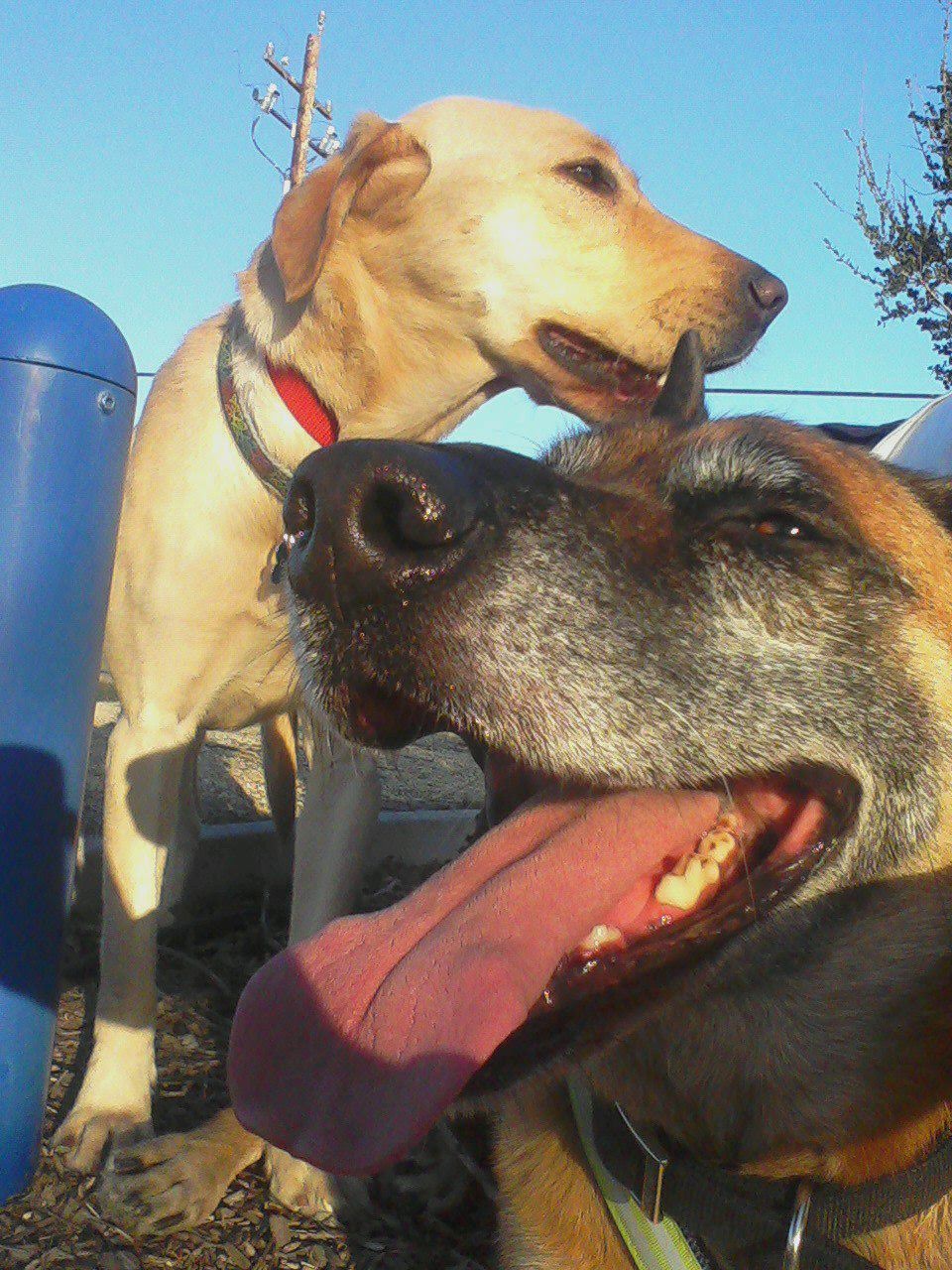
2005-12-21 Cats, the musical
Tired of the chorus of meows on car rides? Spend some time acclimating your cat or kitten to a pet carrier in a fun way. Whether your cat loves treats, brushing, or toys, you can use their favorite activities to help make travel time less stressful for both of you. Start by leaving the cat carrier out when you have no upcoming plans to travel, and then start to incorporate it into your everyday life with your cat. Soon, you’ll find they use the carrier as a place to hide, play, and nap.
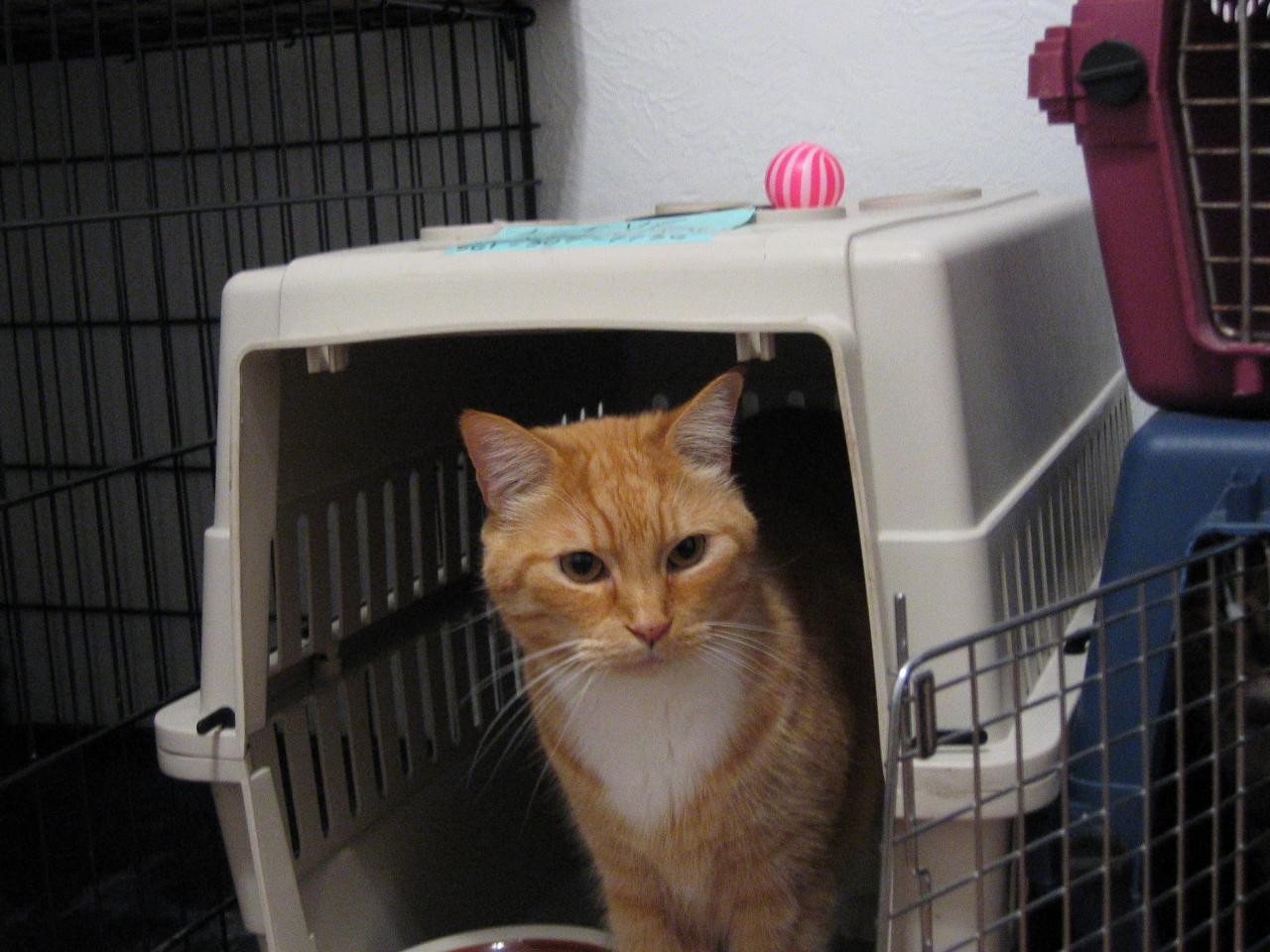
2004-10-18 An Old Trick
It’s easy to get stuck in a habit, but is it a good habit? The tools professionally used in animal training in the past may not be appropriate by today’s standards. We know more now, so implementing new, better designed tools and techniques should be embraced. Don’t be afraid to learn a new trick.
Here we see a lab/Shar Pei mix wearing a head collar. This tool works much like a halter on a horse: it helps lead the animal by its nose in an effort to keep a large, powerful animal from dragging around the smaller handler. Some dogs work very well in head collars, but other dogs find them maddening. It’s a tool that was formally considered universally acceptable, but is now viewed as a much more varied tool depending on the individual dog. As with any tool, proper introductions is a must.
